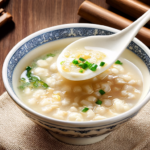Exploring the Flavors of Anhui: Braised Mandarin Squash with Fermented Black Beans
Welcome to another culinary journey in our series “Exploring the Flavors of Anhui.” Today, we’re delving into the rich and diverse cuisine of Anhui province, known for its emphasis on fresh ingredients, natural flavors, and traditional cooking techniques. Our focus today is on a classic dish from this region: Braised Mandarin Squash with Fermented Black Beans. This dish is not only a testament to the culinary artistry of Anhui but also a delightful exploration of texture and flavor that will leave your taste buds craving more.
Introduction to Anhui Cuisine
Anhui cuisine, one of the eight great cuisines of China, is renowned for its simplicity and use of local ingredients. It emphasizes the natural flavors of the ingredients rather than relying heavily on spices or sauces. The dishes are typically prepared using methods like braising, stewing, and steaming, which help retain the freshness and nutritional value of the ingredients. In Anhui, the mountains and rivers provide an abundance of ingredients such as mushrooms, bamboo shoots, and various types of squash, all of which play a significant role in the regional cuisine.
The cuisine of Anhui is deeply rooted in the province’s geography and history. With its proximity to the Yangtze River and the Huai River, Anhui has access to a wide variety of aquatic ingredients. Additionally, the mountainous regions offer a plethora of wild herbs and vegetables, which are often incorporated into dishes to add unique flavors and textures. This dish, Braised Mandarin Squash with Fermented Black Beans, exemplifies the balance between simplicity and complexity that is characteristic of Anhui cuisine.
Ingredients
To prepare this dish, you’ll need the following ingredients:
- 4 medium-sized mandarin squashes
- 3 tablespoons fermented black beans (salted)
- 1 tablespoon garlic, minced
- 1 tablespoon ginger, minced
- 1 teaspoon sugar
- 2 tablespoons soy sauce
- 1 teaspoon sesame oil
- 2 tablespoons vegetable oil
- Salt and pepper to taste
- Water or broth as needed
- Cooking wine (optional)
Mandarin squashes are a staple ingredient in Anhui cuisine, prized for their mild sweetness and soft texture when cooked. Fermented black beans, a common condiment in Chinese cooking, add a savory depth to the dish. Garlic and ginger enhance the aroma, while soy sauce provides umami. Sesame oil adds a nutty fragrance, and cooking wine can be used to further enrich the flavors.
Preparation
Before we begin cooking, it’s important to properly prepare the mandarin squashes. Start by cutting off the top and bottom of each squash, then slice them in half lengthwise. Use a spoon to scoop out the seeds and fibrous parts, leaving just the flesh. Set aside.
Next, prepare the fermented black beans. Rinse them under cold water to remove excess salt, then pat them dry with a paper towel. Finely chop them to ensure even distribution in the dish.
Heat a wok or large frying pan over medium heat. Add the vegetable oil and allow it to heat up. Once the oil is hot, add the minced garlic and ginger. Stir-fry for about 30 seconds until fragrant but not browned. Be careful not to burn the garlic and ginger, as this can impart a bitter taste to the dish.
Add the chopped fermented black beans to the wok and stir-fry for another minute. The beans should start to release their rich, umami flavors. Now, add the sliced mandarin squashes to the wok. Toss the squashes in the oil and bean mixture until they are evenly coated.
Pour in the soy sauce and sprinkle in the sugar. Stir gently to combine. If desired, add a splash of cooking wine at this point to enhance the overall flavor profile. Season with salt and pepper to taste. Add a small amount of water or broth to the wok, just enough to cover the bottom of the squashes. Cover the wok and let the squashes simmer for about 10-15 minutes, or until they become tender and easily pierced with a fork.
Towards the end of the cooking time, drizzle in the sesame oil. This step is crucial as it adds a subtle yet distinct flavor that complements the other ingredients beautifully. Once the squashes are fully cooked and tender, remove the wok from the heat.
Serving Suggestions
Braised Mandarin Squash with Fermented Black Beans is best served warm and can be enjoyed as a standalone dish or paired with rice or noodles. The rich, savory sauce pairs wonderfully with steamed white rice or a bowl of hand-pulled noodles. For a more complete meal, consider adding a side of sautéed greens or a simple stir-fried vegetable dish.
When serving, garnish the dish with a few slices of green onions or a sprinkle of sesame seeds for added color and texture. The combination of the soft, slightly sweet squash and the savory, umami-rich sauce creates a harmonious blend of flavors that is both comforting and satisfying.
Nutritional Information
This dish is not only delicious but also nutritious. Mandarin squashes are rich in vitamins A and C, potassium, and dietary fiber, making them beneficial for maintaining healthy skin, boosting immunity, and supporting heart health. Fermented black beans are a good source of protein, iron, and antioxidants, contributing to overall well-being. The dish is low in calories and fat, making it a healthier alternative to many other meat-based dishes.
It’s worth noting that the sodium content of this dish may be higher due to the use of fermented black beans and soy sauce. However, this can be adjusted by reducing the amount of these ingredients or opting for low-sodium alternatives. Always consider portion control and balance with other meals throughout the day.
Conclusion
Braised Mandarin Squash with Fermented Black Beans is a true gem of Anhui cuisine, showcasing the province’s dedication to using fresh, local ingredients and traditional cooking methods. The combination of tender squash, savory black beans, and aromatic seasonings results in a dish that is both comforting and sophisticated. Whether you’re a seasoned chef or a beginner in the kitchen, this recipe offers a delightful way to explore the flavors of Anhui.
We hope you enjoy preparing and savoring this dish as much as we do. Stay tuned for more culinary adventures in our ongoing series “Exploring the Flavors of Anhui.” Happy cooking!


